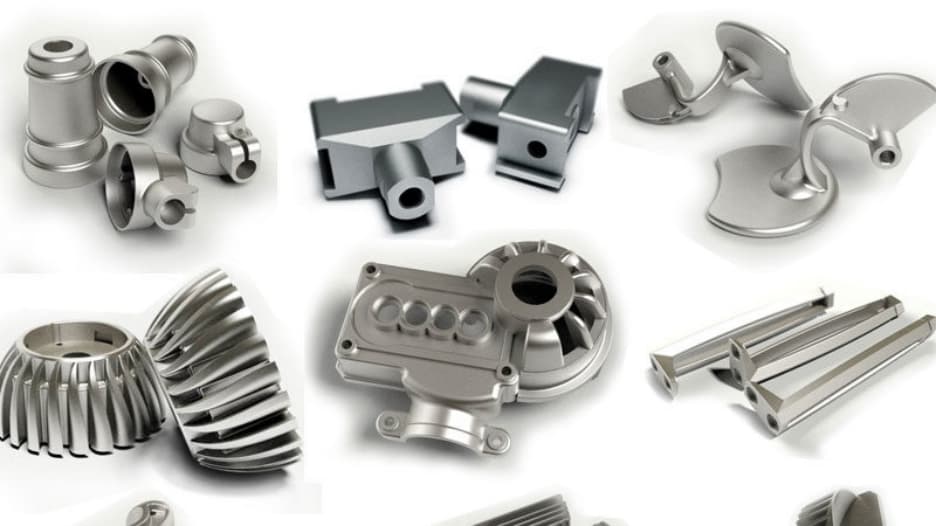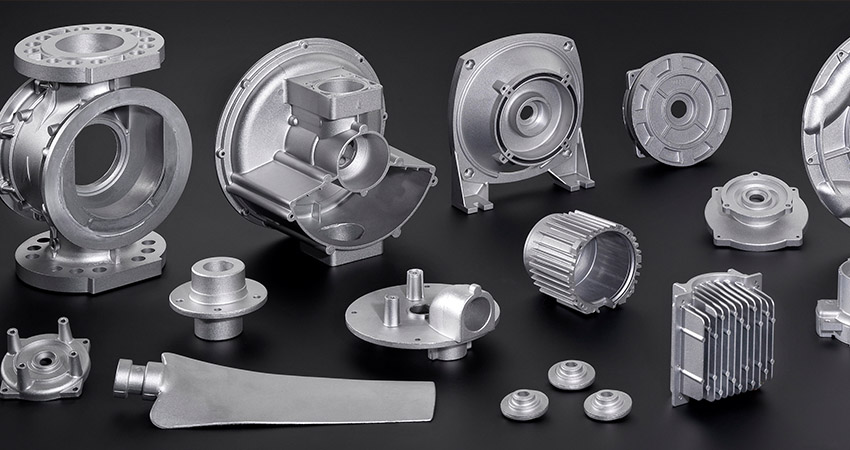Recognizing the Benefits and Varieties of Aluminum Castings in Sector
Aluminum castings have become significantly important across different markets as a result of their unique residential or commercial properties and manufacturing adaptability. Their light-weight and corrosion-resistant nature makes them ideal for requiring applications. Various spreading techniques permit exact and detailed layouts. As markets advance, comprehending the variety of light weight aluminum spreading choices and their advantages is essential. This expedition questions concerning their future duty in manufacturing and sustainability. What lies in advance for light weight aluminum in these markets?
The Fundamentals of Aluminum Casting Processes
Although aluminum spreading processes vary in strategy, they all share a common objective: to transform liquified light weight aluminum right into precise shapes and components. The primary techniques of aluminum casting consist of sand casting, die spreading, and investment casting. In sand casting, molds are created making use of sand, enabling intricate styles however typically leading to a harsh surface coating. Die casting employs high-pressure shot of molten light weight aluminum right into metal molds, generating high precision and smooth surface areas, appropriate for automation. Financial investment casting, or lost-wax casting, entails developing a wax pattern coated with a ceramic covering, providing remarkable information and dimensional precision. Each technique has its particular applications and factors to consider, including price, production volume, and complexity of the forms generated. Recognizing these fundamental strategies is essential for markets that count on aluminum castings to meet their design and functional demands.
Key Benefits of Using Aluminum Castings
Aluminum castings provide various benefits that make them a recommended option in numerous industries. One of the vital benefits is their lightweight nature, which enables simpler handling and lowered shipping expenses. This particular adds to boosted power efficiency, specifically in vehicle and aerospace applications. Additionally, aluminum displays outstanding deterioration resistance, extending the lifespan of components and minimizing upkeep demands.
One more benefit is the adaptability of light weight aluminum castings, which can be built right into intricate forms, making it possible for ingenious styles that conventional products may not accommodate. The thermal and electric conductivity of light weight aluminum likewise makes it excellent for applications requiring warmth dissipation or reliable electrical links. Moreover, light weight aluminum castings are recyclable, straightening with sustainability goals and reducing environmental influence. On the whole, the combination of stamina, sturdiness, and flexibility makes light weight aluminum castings a critical component in modern-day manufacturing techniques across multiple sectors.
Typical Kinds Of Aluminum Castings
Aluminum castings are created with various approaches, each fit for various applications and demands. Amongst the most usual methods are sand spreading, which supplies versatility and cost-effectiveness, and pass away casting, understood for its precision and efficiency. Recognizing these processes is vital for selecting the suitable casting method for specific commercial demands.
Sand Casting Refine
A considerable part of light weight aluminum castings in market is created with the sand spreading process, which is renowned for its versatility and cost-effectiveness. This method involves producing a mold from a sand mixture, permitting the production of intricate forms and big elements. Sand spreading is especially beneficial for little to medium-sized production runs, as it needs very little preliminary investment in tooling. The procedure starts with pattern making, followed by mold preparation, pouring liquified aluminum, and lastly, cooling and ending up. The high thermal conductivity of aluminum assurances even cooling, reducing the danger of defects. Subsequently, sand casting remains a preferred option for manufacturers looking for efficiency and versatility in their light weight aluminum casting applications.
Die Casting Techniques
Die casting techniques stand for a highly reliable technique for creating aluminum castings, especially suited for high-volume production. These methods largely consist of two usual kinds: hot chamber and cool chamber pass away spreading. In hot chamber die casting, the molten aluminum is infused into the mold and mildew from a tank that is heated up, making it perfect for low-melting-point alloys. Conversely, cold chamber die casting involves pouring the molten aluminum into a separate chamber prior to injection, which accommodates greater melting-point products. Both approaches use precision in shaping complex geometries and attaining exceptional surface area coatings. Furthermore, die spreading is known for its fast cycle times, decreasing manufacturing costs while maintaining uniformity in quality across large amounts of parts.
Applications in the Automotive Industry
Transforming car layout and efficiency, light weight aluminum castings play a vital function in the automotive sector. These castings add considerably to weight decrease, enhancing fuel effectiveness and total car characteristics. Secret applications consist of engine blocks, transmission real estates, and suspension components, where their light-weight nature and stamina are important.
Aluminum castings additionally enable complicated geometries, allowing makers to develop elaborate styles that maximize air flow and lower drag. This capability is especially advantageous in electrical and hybrid lorries, where performance and efficiency are paramount.
Additionally, the rust resistance of light weight aluminum extends the lifespan of auto parts, minimizing maintenance costs and enhancing lorry dependability. The versatility of light weight aluminum castings supports both mass manufacturing and personalized applications, making them a preferred option amongst automobile engineers and visit here designers. Aluminum Casting. As the market continues to innovate, aluminum castings will continue to be an important element in the quest of advanced automotive innovations
Aerospace Industry Application
In the aerospace industry, light weight aluminum castings are integral to the layout and capability of airplane components. These castings are made use of in numerous applications, including engine components, architectural components, and interior installations. Their light-weight nature adds to boosted fuel efficiency and general efficiency, which is important in aerospace engineering.
Aluminum castings additionally offer outstanding strength-to-weight ratios, allowing suppliers to develop elaborate styles without jeopardizing architectural honesty. The capability to produce complicated geometries makes aluminum casting a preferred selection for components that call for accuracy and integrity.
Additionally, light weight aluminum's resistance to deterioration enhances the long life of aerospace parts, reducing upkeep expenses and enhancing safety and security (Aluminum Casting). The casting procedure permits for high-volume manufacturing, meeting the market's needs for efficiency. Generally, aluminum castings play a critical role ahead of time aerospace modern technology and optimizing aircraft design, adding to the sector's recurring innovations

Benefits Over Various Other Materials
Aluminum castings provide substantial advantages over other products, making them a favored selection in different markets. One of the key benefits is their light-weight nature, which adds to reduced power consumption and improved efficiency in applications such as automobile and aerospace. Additionally, light weight aluminum exhibits exceptional corrosion resistance, enabling prolonged resilience and decreased upkeep prices.
The product's premium thermal and electric conductivity better enhances its charm, specifically in applications needing warmth dissipation or reliable energy transfer. Aluminum Casting. Aluminum castings additionally offer outstanding dimensional security, making certain specific resistances and minimizing the chance of problems during the manufacturing procedure
Moreover, the convenience of aluminum enables for complex forms and intricate designs, which can be attained through different casting methods. This versatility makes aluminum an important option for producers intending to innovate while maintaining cost-effectiveness and top quality. In conclusion, light weight aluminum castings attract attention because of their distinct mix of buildings that accommodate varied commercial requirements.
Future Patterns in Aluminum Casting Modern Technology
Future fads in aluminum spreading modern technology are increasingly concentrated on automation and the advancement of sophisticated alloys. Automation stands to enhance effectiveness and precision in casting processes, reducing labor prices and improving item uniformity. Simultaneously, improvements in alloy formulas promise to increase the range of applications for light weight aluminum castings, attending to particular efficiency demands in numerous markets.
Automation in Casting Procedures

Advanced Alloys Development
With the ongoing advancement of product scientific research, the advancement of sophisticated alloys is established to transform light weight aluminum casting technology significantly. These cutting-edge alloys are developed to enhance mechanical buildings, corrosion resistance, and thermal security, accommodating diverse commercial applications. Researchers are concentrating on hybrid alloys that include aspects such as magnesium, silicon, and zinc to achieve peak efficiency. Additionally, Click Here advancements in computational modeling and simulation are allowing the forecast of alloy habits under different conditions, streamlining the style process. The integration of recycling innovations is additionally ending up being vital, permitting manufacturers to create high-performance light weight aluminum castings while lessening environmental effect. As these fads continue, the light weight aluminum spreading market is likely to witness considerable enhancements in performance, sustainability, and product top quality.
Frequently Asked Inquiries
Exactly How Is Aluminum Casting Eco-friendly?
The question of aluminum casting's environmental kindness occurs from its recyclability and lower energy intake compared to other metals. In addition, developments in lasting techniques better boost its green online reputation within manufacturing processes.
What Is the Common Lifespan of Aluminum Castings?
The normal lifespan of light weight aluminum castings differs based upon application and atmosphere, typically varying from numerous years to decades. Variables such as exposure to harsh elements and mechanical tension can greatly affect their durability and longevity.
Can Aluminum Castings Be Reused?
Aluminum castings can certainly be reused. This procedure substantially lowers waste and preserves resources, allowing suppliers to recycle materials effectively. Recycling aluminum castings adds to sustainability and minimizes the environmental impact connected with light weight aluminum production.
What Are the Usual Issues in Aluminum Castings?
Common defects in aluminum castings include porosity, contraction, imbalance, and surface area imperfections. These problems can arise from insufficient putting strategies, incorrect alloy structure, or inadequate air conditioning, eventually affecting the quality and efficiency of the final product.
Exactly how Do I Select the Right Aluminum Casting Refine?
Choosing the ideal aluminum spreading procedure calls for evaluating production quantity, component intricacy, and desired buildings. Factors such as price, lead time, and material features additionally affect the choice, ensuring suitable outcomes for certain applications.